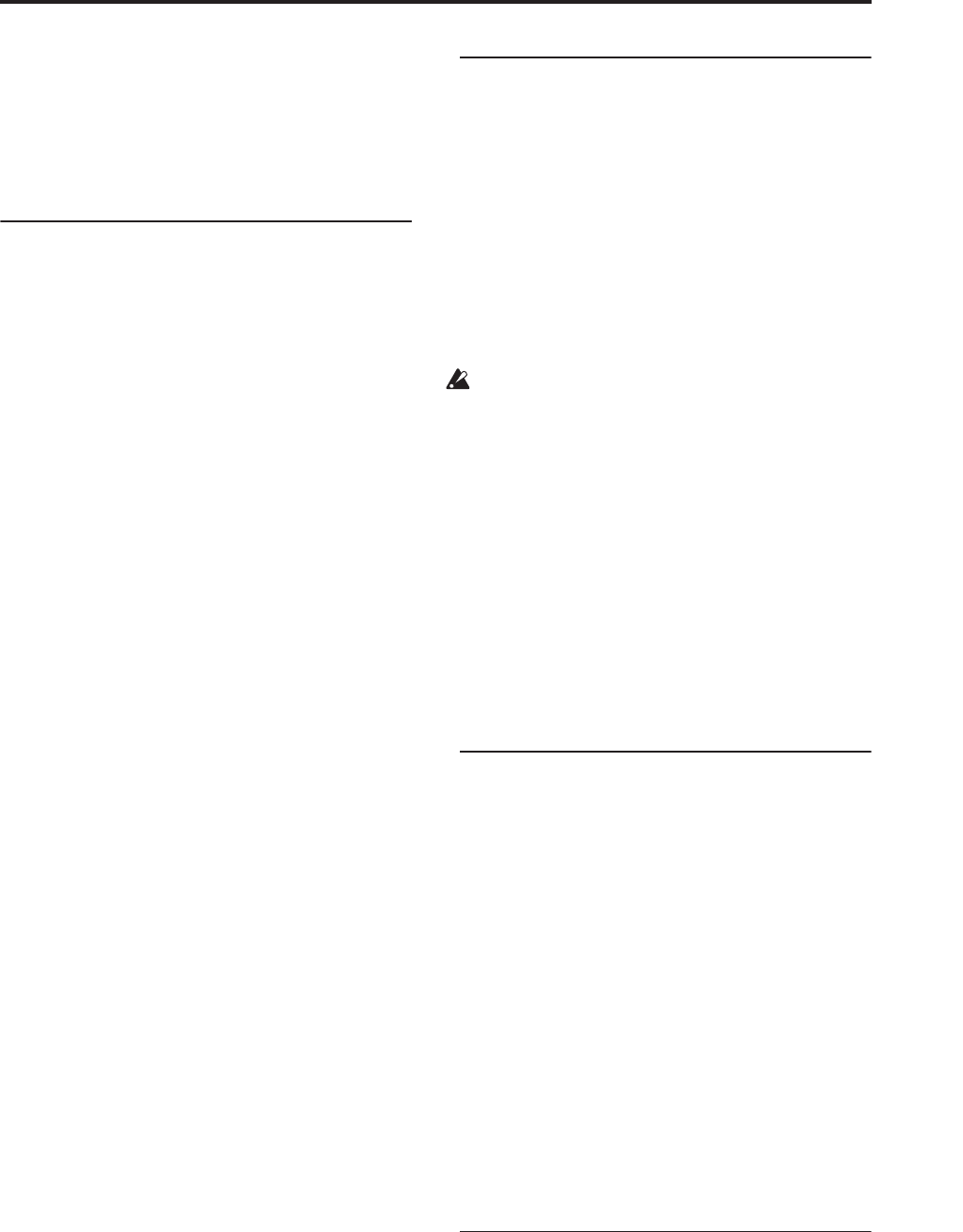
EXi Program P4: Basic/Vector 4–1: Program Basic
161
01-09: Unison voices will be detuned in an asymmetric
way, increasing the complexity of the detune, and
changing the way in which the different pitches beat
against one another. This creates an effect similar to
vintage analog synthesizers, in which oscillators were
frequently slightly out of tune. Higher numbers
increase the effect.
4–1d: Key Zone
You can create keyboard splits by setting top and
bottom keys for EXi 1 and 2. Also, you can control the
keyboard range over which the Hold parameter takes
effect.
Setting Key Zones from the keyboard
In addition to using the standard data entry controls,
you can also set all keyboard zones parameters directly
from the keyboard. Just do the following:
1. Select the key zone parameter you’d like to edit.
2. Press and hold the ENTER button.
3. Play a note on the keyboard to set the parameter.
4. Release the ENTER button.
You can use this shortcut for all key and velocity
parameters in the OASYS.
EXi 1 Bottom [C-1…G9]
This sets the lowest key on which EXi 1 will play.
EXi 1 Top [C-1…G9]
This sets the highest key on which EXi 1 will play.
EXi 2 Bottom [C-1…G9]
This sets the lowest key on which EXi 2 will play.
EXi 2 Top [C-1…G9]
This sets the highest key on which EXi 2 will play.
Hold [On, Off]
Hold is like permanently pressing down on the sustain
pedal. In other words, notes continue to sound as if
you were holding down the key - even after you lift
your fingers from the keyboard.
Unless the Sustain Level is set to 0 in Amp EG 1 (and
Amp EG 2 in a Double Program), the sound will
continue to play forever–or, for EXi which support
samples, it will play for the entire length of the
sample(s).
On (checked): The Hold function is enabled for the
range set by the Hold Bottom and Hold Top
parameters, below.
Off (unchecked): Notes will play normally. This is the
default setting.
Hold Bottom [C-1…G9]
This sets the lowest key affected by the Hold function.
Hold Top [C-1…G9]
This sets the highest key affected by the Hold function.
4–1e: Scale
Type [Equal Temperament…User Octave Scale15]
Selects the basic scale for the Program.
Note that for many of the scales, the setting of the Key
parameter, below, is very important.
For a complete list of the available scales, please see
“1–1g: Scale” on page 36.
Key (Scale Key) [C…B]
Selects the key of the specified scale.
This setting does not apply to the Equal Temperament,
Stretch, and User All Notes scales.
If you’re using a scale other than Equal
Temperament, the combination of the selected scale
and the Key setting may skew the tuning of the
note. For example, A above middle C might become
442 Hz, instead of the normal 440 Hz. You can use
the Global Mode’s Master Tune parameter to
correct this, if necessary.
Random [0…7]
This parameter creates random variations in pitch for
each note. At the default value of 0, pitch will be
completely stable; higher values create more
randomization.
This parameter is handy for simulating instruments
that have natural pitch instabilities, such as analog
synths, tape-mechanism organs or acoustic
instruments.
4–1f: Note-On Control
EXi 1 Delay [0ms…5000ms, KeyOff]
Use this to create a delay between the time that you
press a key, and the time that EXi 1’s note actually
sounds.
This is most useful in Double Programs, for delaying
one EXi in relation to the other.
KeyOff is a special setting. Instead of delaying the
sound by a particular amount of time, the sound will
play as soon as you release the key.
You can use this to create the “click” heard when a
harpsichord note is released, for instance.
In general, when you use the KeyOff setting, it’s also
best to set the Amp EG Sustain Level to 0 (assuming
the EXi includes an Amp EG).
EXi 2 Delay [0ms…5000ms, KeyOff]
This controls the note-on delay for EXi 2. For more
information, see “EXi 1 Delay” on page 161.
4–1g: Half-Damper Control
A half-damper pedal is a special type of continuous
foot pedal, such as the Korg DS-1H. In comparison to a
standard footswitch, half-damper pedals offer more
subtle control of sustain, which can be especially useful
for piano sounds.


















